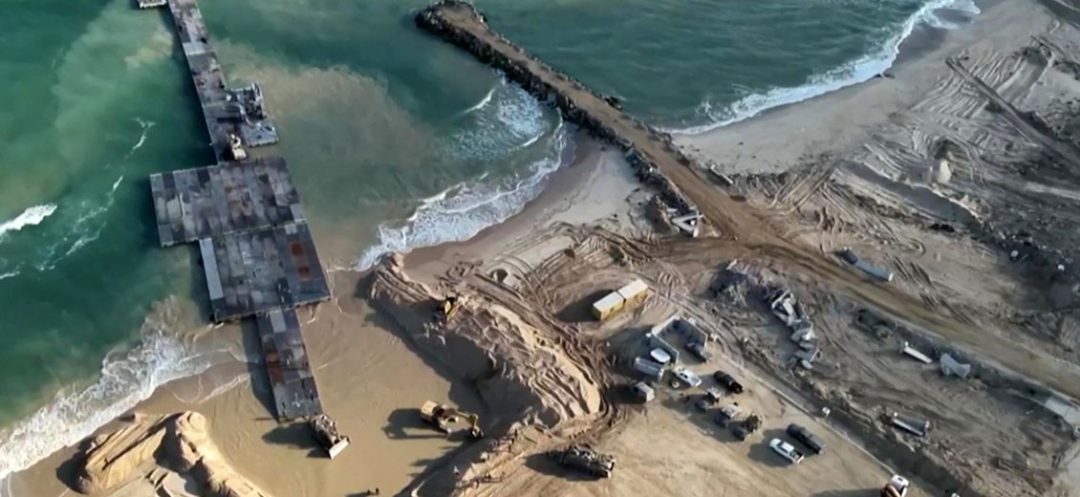Listen to the article
In early March, US President Joe Biden made an announcement regarding the construction of a floating dock off the coast of Gaza. The project has been a hot topic ever since. The aim is to deliver humanitarian aid to the enclave following the closure of land crossing points by the Israeli army. Beyond the humanitarian issue, what strategic objectives might this initiative serve?
A floating jetty constructed off Gaza by the American military has been delivering aid to Gaza since May 17. The enclave has been facing a humanitarian disaster since October 7.
Costing $320 million, this floating port is very vulnerable to adverse weather conditions. Destroyed twice by storms and then rebuilt, it was dismantled at the end of June and towed to Ashdod port in Israel. This relocation, not the first, aims to “avoid potential structural damage” due to the rough seas, according to Pentagon Deputy Press Secretary Sabrina Singh.
It is therefore legitimate to question the possible objectives behind such a “temporary” structure.
Strategic Communication
According to General Dominique Trinquand, a specialist in international relations, this maritime platform constitutes an “American communication element to show support for the Palestinians in the humanitarian field.”
“The United States wants to show that it is doing something for the benefit of the Gazans despite Israeli reluctance that hinders the delivery of aid by land,” he explains to This is Beirut.
Sabrina Singh stated at the end of June that “more than 8,831 tons of humanitarian aid have been delivered since the temporary floating jetty became operational on May 17.” She thus estimated that the operation is a “great success.”
This is what retired General Maroun Hitti calls “strategic communication,” in the sense that this project constitutes “an argument for the Biden administration against its detractors who criticize American support for Israel.” It would be a “concrete proof showing that the United States is indeed helping the Gazans, following Israel’s closure of all land crossings to Gaza, by delivering supplies directly to the enclave without passing through Israeli territory,” continues General Hitti.

He also notes that this technique of a portable artificial port in times of crisis is not new. Eighty years ago, Anglo-American engineers set up structures called Mulberry on the Normandy coast in 1944 to support ground forces during the Allies’ landing.
A Dual Political Objective, for Gaza and the Region
“There is no war without a political aim, and conversely, political objectives are always achieved by military means,” says Hitti.
According to him, the American intervention via the floating port falls within the framework of a third undeclared objective of the war waged by Israel in Gaza. After the liberation of hostages and the eradication of Hamas’ military infrastructure, Tel Aviv and its American ally would aim to establish a new political authority in Gaza. They seek to “transfer the administration of the strip from Hamas to any other authority, whether UN, Palestinian and Israeli combined, it does not matter.”
Currently, supply for the Gazan people has a single source: the US, which delivers aid by sea through floating docks, and Israel that ensures its distribution by land.

Thus, “these two states become providers of security, both economic and physical, automatically discrediting Hamas, which will be, de facto, replaced by another authority,” argues General Hitti.
According to him, “the West now wants to shift the balance of power” following the attack by Hamas, supported by Iran, against Israel.
“The power struggle in this war is taking place between Washington and Tehran,” he said, adding, “this leads to the second regional objective: achieving normalization between Israel and the Arab countries, in accordance with the 2020 Abraham Accords.”
This would counter Iran by proving that its strategy—the October 7 attack—to curtail the normalization process between Riyadh and Tel Aviv has failed.
In this context, the Biden administration is about to finalize a mutual defense treaty between the United States and Saudi Arabia against Iran. An American “tempting offer,” in General Hitti’s terms, in exchange for the development of Israeli-Saudi diplomatic relations.
“It remains to be seen whether this step will be taken before or after the proclamation of a Palestinian state, because as long as these people have not obtained their rights, there will always be Palestinian resistance,” he concluded.
A Controversial Undertaking
Far from unanimous, the American floating jetty initiative has been the subject of several criticisms, both in Gaza and the United States.
While the United Nations had welcomed “any effort to ensure the delivery of humanitarian aid to Gaza,” they insisted that the jetty is “intended to complement existing land crossing points,” but “not to replace them.”
For their part, humanitarian organizations have criticized the project’s insufficient results, given the “immense” needs on the ground.
Farhan Haq, deputy spokesman for the UN Secretary-General, Antonio Guterres, had already emphasized last May that humanitarian aid “cannot and should not depend on a floating jetty,” raising another central problem, that of transport. Whether the aid is delivered “by sea or by road, it will not reach those who need it without fuel,” he noted.
Moreover, in Washington, Mike Rogers, chairman of the House Armed Services Committee, reportedly urged the US administration on June 21 “to immediately end this failed operation,” calling “to consider other land and air means of delivering humanitarian aid.”
As of June 23, the jetty had only been usable for 12 days since its operations began on May 17.
For now, Sabrina Singh says she is unable to specify “a date for the reinstallation of the jetty.”
More on the subject soon…





